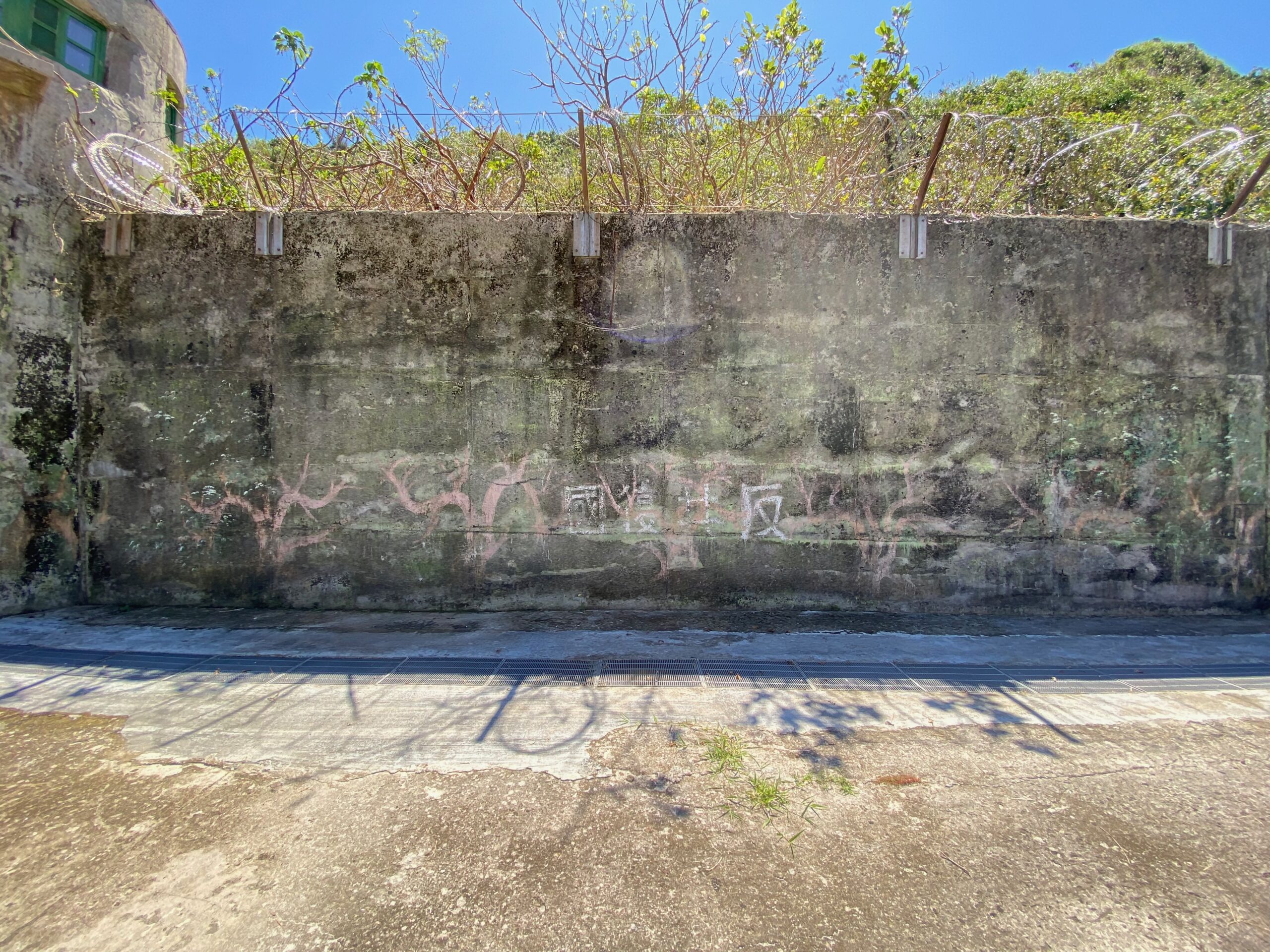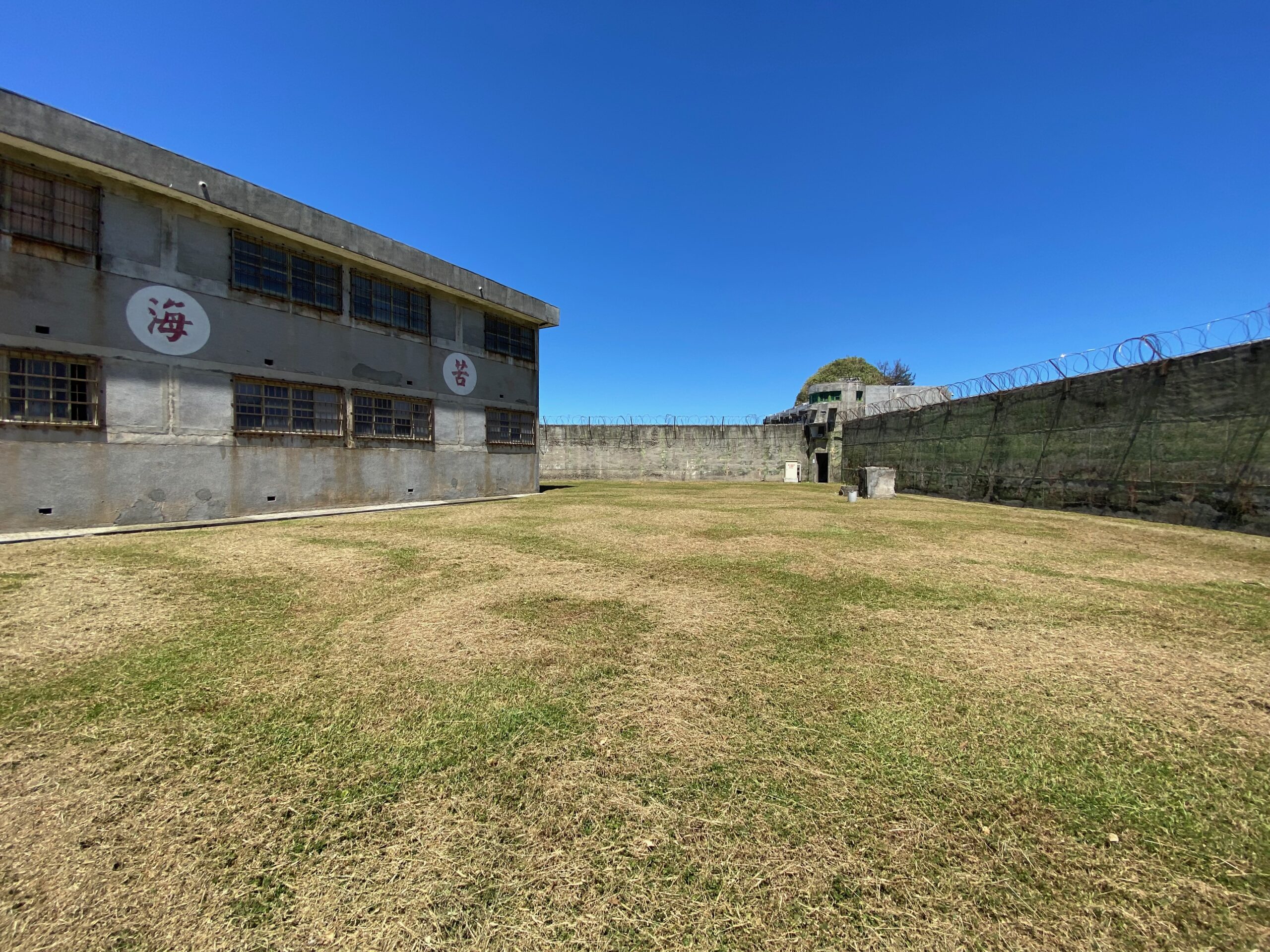綠島是白色恐怖時期監獄遺址所在地。在往常的討論中,經常更加著重探究、還原島上監禁政治犯的歷史,卻忽略其強烈的天候與環境條件,如何可能改變人們看待歷史的方式。當1990年代,人們開始追溯白色恐怖歷史時,綠島成為了歷史暴力的象徵之地,卻也似乎呼應歐文・史特勞斯(Erwin STRAUSS)在《從感官的角度來說》(Du sens des sens,2000)中所提及之:憂鬱者與地景失去連結,而不再能感知周遭環境。然而,綠島的自然環境從來無法使人忽視,無論是在地方誌、或者從小成長於綠島的居民口中,強烈的海風、日照、暑熱,一直以來都是生存在島上的重大考驗。如此一來,我想要提問的是:人們如何在這樣一座島上進行紀念?
這年(2023)登上綠島時,已經是人權藝術季的尾聲。因為秋初襲來的幾個強颱,我幾次改動了登島時間,出發前一天又看見因颱風破壞電路、展場暫時關閉的消息。我懷著緊張的心情搭上前往臺東的火車、坐上開往綠島的客船,踏上綠島,迎面而來的是炎熱的天候。連著幾天徒步前往人權園區,沒有任何遮蔽的路上海風吹來、日照蒸曬,滯悶的展覽空間一如以往考驗著我的觀看和思考意志。
每一次登島都是如此;一踏上綠島,島上的自然環境就會鋪天蓋地襲來,壓倒性地征服著人的理性。事實上,在前往綠島的途中,我還夾纏在關於紀念碑的難題,想著綠島舊監獄在黨國時期留下的紅色標語,無處不在的塑像與遺跡,如何訴說著島上的歷史,且使其長久承載著橫跨海峽乃至整座太平洋的政治欲望。不只關於統獨,更關乎左右,綠島像是一道太平洋上小小的裂口,在種種話語之中被反覆爭來搶去。也許對於曾為這座監獄登上綠島的所有人來說,它所負載的過去,實則牽動著本島族群衝突、政治矛盾的一道傷口。而對於心繫著過往傷痛的受難者與家屬而言,沉重的話題「如何談論下去」,又是另外一道更為難解的問題。
這樣的難題在登島的那刻,就被綠島強烈的氣候環境瞬間截斷。我想起安清(Anna Lowenhaupt TSING)在《擴散》(Proliférations,2022)裡令人警醒的句子:比起前幾年人們沉迷的人類世之說,「全新世一直都存在著。」(Holoscène est toujours là.)在特定環境條件之下,非人類的世界,有時可以輕易地摧毀以人類為中心的敘事,讓所有留存歷史的嘗試變得徒勞。
就像是綠島極端的天候條件,毫不客氣地壓倒了我腦海中關於歷史與政治的糾結。在綠島,不義遺址的拆或不拆,問題可能並不只在於意識形態或政治認同,任何紀念活動、保存的意圖,都隨時可能被強悍的環境阻斷。當我看見新生訓導處展區利羅伊・紐(Leeroy NEW)幾近全毀的竹編船艦、羅懿君和張紋瑄在颱風之前就已部份提前卸除的裝置,遺憾的同時,終於不得不承認:在強風豪雨、海風鹽分的侵蝕之下,紀念的行動並不如我們所想像的穩定恆久⸺它也可能脆弱非常。
 利羅伊・紐《描籠涯船/描籠涯(船/村莊)》(2023)為颱風席捲後的局部。圖/許楚君攝影
利羅伊・紐《描籠涯船/描籠涯(船/村莊)》(2023)為颱風席捲後的局部。圖/許楚君攝影
與此同時,綠島又承載著白色恐怖歷史,以及由此投映的共同體想像。在許多研究者眼中,這是一處創傷事件的「後遺風景」(le paysage après-coup);在創傷事件發生之後,它將成為一道永遠無法被平撫的傷疤,留存在島上,隨著時間的推進、人們不斷更新的詮釋改變面貌,而刻寫在其上的痕跡,則見證著曾經存在的歷史。見證著歷史的風景,在各種論述之中逐步轉化為國族與認同的匯聚點,終於又成了一種固定的符號,人們藉此標誌自身對於歷史的想像。
靠近公館海岸的白色恐怖綠島紀念園區,羅列受難者名單的紀念碑形式,就標記著上述對於創傷地景典型的理解方式:在創傷事件的原址,建立起記憶的錨點。關於這座紀念碑的敘事,在由國家所主導的紀念活動中慢慢形成,譬如從2000年左右開始,每年都聚集起四百多位受難者與家屬,紀念從二二八事件以至於白色恐怖時期,臺灣「爭取自由人權的歷史」。在長達十數年的紀念活動之中,這幾乎成為關於二二八與白色恐怖的固定論述,也牽動著臺灣主體認同的形塑過程。
這樣的主體認同形塑也可能存在危險。陳香君早已在《紀念之外:二二八事件・創傷與性別差異的美學》(2014)裡,對於二二八紀念活動與歷史化提問,指出它如何形構了新臺灣國家論述,並且如皮耶・諾哈(Pierre NORA)所提出的「記憶所繫之處」(lieu de mémoire)的物質或非物質形式,形塑出文化認同與傳統。陳香君銳利地指出,人權園區在臺灣的脈絡中,更是從種種創傷、防衛、精神官能症爆發、壓抑的復返之中,重複著創傷結構。
倘使朝向共同體的紀念(commemoration),指向的是這樣的封閉循環,那麼,我們必須思考的或許就不只是「如何讓不義歷史的話題持續下去」,而是「是否可能存在另外一種脆弱的紀念形式」?一種脆弱的紀念,既是共同體的集體行動(co-),作為奠基於經驗之上的記憶工作(-memoration),又同時在內部充滿阻斷、衝突與差異。它可能存在嗎?它將以何種方式存在?
 刻寫在島上的痕跡,見證著曾經存在的歷史。圖/許楚君攝影
刻寫在島上的痕跡,見證著曾經存在的歷史。圖/許楚君攝影
從1990年代到今天,紀念的型態似乎又有了近一步轉變;從2019年的「拜訪流麻溝15號」開始,至去年首度轉為雙年展模式的「傾聽裂隙的迴聲」,當代藝術創作近年隨「綠島人權藝術季」被系統性地帶到了島上。對於綠島當地居民,乃至於政治受難者及家屬而言,多數的藝術家是從本島來的「外來者」,也是白色恐怖紀念的「遲到者」⸺他們惴惴不安地在其懷疑聲中嘗試靠近綠島、靠近歷史。即便藝術季的幾位策展人透過諸種「共創」、「共學」與踏查活動,屢屢嘗試連結起藝術家、居民、受難者前輩,仍然無法迴避此一事實。
在〈反思「綠島人權藝術季」:綠島觀點〉(童詠瑋,2021)的訪談裡,任職人權館、作為館方與藝術季之間第一線橋樑的蔡美娟,提及「居民的戒心一年比一年重」,正說明了數十年來前仆後繼的研究調查,如何激發綠島在地居民,或者白色恐怖政治受難者的免疫反應。本島與離島、兩造之間存在的張力,在種種連結在地、反照當代的論述之下,實則潛伏著這座小小島嶼上長久存在、被掩蓋在各種官方論述之下的緊張。藝術家與研究者從本島而來,在各種訪談與閱讀當中採集島上的素材;當地居民與政治受難者,夾處在反覆的審視與提問之中或進或退。
園區往昔的紀念活動,所導向的既定論述與意識形態,顯然無法讓這種緊張關係得到揭露。相對的,本島帶來的研究調查「污染」與相應的免疫狀態,則反映著紀念碑所形塑的歷史敘事,也許從來都只是一種穩固的幻象,而所謂持續性的紀念可能無法真正存在於綠島。從島上強悍的天候與自然條件,到紀念行動之中各種分裂的認同與欲望,多重因素彼此交織,實則從內部裂解了綠島上關於白色恐怖歷史的紀念。前述所謂「脆弱的紀念」,即是在綠島本身的自然條件,以及多重人際與政治張力之下,所發展出的一種紀念模式。
 另外一種脆弱的紀念形式,它可能存在嗎?它將以何種方式存在?圖/許楚君攝影
另外一種脆弱的紀念形式,它可能存在嗎?它將以何種方式存在?圖/許楚君攝影
在颱風過後最酷熱的下午,我走進劉紀彤《後來的人寄出的風景》(2023)位於綠島山莊八卦樓牢房內的展間。因為悶熱的空氣,漸失去思考能力之時,我看見藝術家在牆角貼上的一張留言:在這個空間裡想必很悶熱難受吧,就請忍耐一下,坐下來讀幾段故事,選張明信片,寫下你對於風景的想法。
是的,「忍耐」。不同於恆溫恆濕的白盒子,在綠島上確實需要更強烈的意志,才能夠說服自己繼續待下來。在這裡,藝術家並非要向觀眾說教,也不再復述曾經的政治受難者在這座牢獄內何其艱辛。她說的,是此時此刻站在展場裡,作為歷史的後至者、島嶼的外來者,作為觀者的艱辛。在看到她的留言之前,我沒有想過,在綠島上、在白色恐怖的歷史面前,我們的身體與心理可能經受著怎樣的考驗,又需要花費多少力氣才能夠克服,或者,才能夠只是坐下來,匆匆看一眼藝術家所留下的片段訊息。
 《後來的人寄出的風景》綠洲山莊八卦樓展場一隅,「2023綠島人權藝術季⸺傾聽裂隙的迴聲」。圖/劉紀彤提供
《後來的人寄出的風景》綠洲山莊八卦樓展場一隅,「2023綠島人權藝術季⸺傾聽裂隙的迴聲」。圖/劉紀彤提供
為了自身的研究工作,我留在展場裡仔細讀完劉紀彤放在小竹椅上的作品,以及懸掛在窗邊的一張張明信片。在這數十分鐘裡,也有零零星星地幾個訪客從門口探探頭後旋即離去。究竟是什麼驅使綠島外的其他旅人,來到這座離島,來到這座悶熱、陰沉的舊監獄,坐下來閱讀這段陌生複雜的敘事,甚至寫下自己的感覺?劉紀彤的寫作,為我的疑惑提供了一點可能的線索:在這座島上,凝聚起共同意識的紀念實則不可能發生;真正存在的是在嚴酷的環境之中,不斷流動分神的分裂狀態。
這件作品本身對於風景的感知經驗,也已然反映了這種分裂性:「後來的人」尋訪政治受難者陳孟和在綠島服刑期間所留下的大量影像紀錄,重新來到原址拍下新的照片,並對照兩者、留下五篇寫作。比如其中的〈背上有字的石頭〉,敘事者循著檔案照片來到一顆刻著「毋忘在莒」的石頭前。當年,陳孟和拒絕拍下政宣標語,因而選擇從石頭背面取景。從刻寫著國民政府標語的石頭正面、政治受難者轉向的石頭背面,再至「戒嚴以後出生」、「讀著非國立編譯館的教科書長大」、「看著這四個字,起初自然地唸出『母忘在呂』」的敘事者劉紀彤,三重視線於兩張照片的對照之中共存,在對於歷史互不相容的詮釋之中,留下了各行其是的記憶。
 陳孟和+後來的人們+劉紀彤,2023,〈背上有字的石頭〉,《後來的人寄出的風景》,明信片、文本、網路平台、裝置。圖/劉紀彤提供
陳孟和+後來的人們+劉紀彤,2023,〈背上有字的石頭〉,《後來的人寄出的風景》,明信片、文本、網路平台、裝置。圖/劉紀彤提供
毫無共識、不連貫的記憶,這是否可能就是綠島上,因著強悍的自然條件、因著迥異的族群認同與意識形態,所發展出的一種紀念形式?又或者,它甚至更接近多數人所經驗到的真實。在這樣充滿著差異的紀念之中,人與風景並無法真正地成為見證者,也無法形成共同的記憶,因為他們各自的證詞,都足以否定彼此的說法。甚至,無時無刻不被強烈天候所侵蝕與變造的風景,反而印證了證詞的可疑。這些衝突的觀點卻同時存在於名為「紀念」的活動之中,卻也無法讓紀念發展成長久而穩固的集體記憶,乃至於凝聚成單一的集體認同。
那麼,矛盾的複數記憶又如何紀念?在離開綠島之後,經歷了一個小時狂風暴雨的搖撼,我終於在富岡漁港碼頭找到劉紀彤本次參展的第一件,也可以是最後一件作品〈那座到不了的島〉。她將陳孟和從本島拍下的綠島倒放重製,放在碼頭的上下船處。藝術家眼裡的綠島,是從船上搖搖晃晃、讓人無法集中注意力的眩暈之中,遙遙在風雨和海浪之間浮現的一座島。
 《後來的人寄出的風景》富岡漁港登船步道展場一隅,「2023綠島人權藝術季⸺傾聽裂隙的迴聲」。圖/黃雅農攝影,均勻製作提供
《後來的人寄出的風景》富岡漁港登船步道展場一隅,「2023綠島人權藝術季⸺傾聽裂隙的迴聲」。圖/黃雅農攝影,均勻製作提供
這件作品提示了視差的觀看方法:回望、投映、對位。劉紀彤自2021年隨藝術季登島駐村後,持續將創作延展迄今1。在反覆的視線往返之中,她因駐地所開啟的本島踏查研究,包含著從綠島映射而來的眼光;當她登上綠島時,則必然帶著本島的欲望投射。兩地的相互投映,實則建立在無法看清的迷離想像、既定敘事中的再現符號之上。然而,回望不只是視線的來回移動,同時是身體的對位。劉紀彤走入楊逵位於東海花園的故居,走入承載著歷史的綠島地景之中,又於隔年重回島上,向居民學習海中立泳,學習用自己的身體感知,嘗試對位史料、研究與口述中,原本應該存在、卻早已物是人非的現場。這樣的動作並非在驗證歷史的真偽,而是間接投映出她與她所凝視的過去,在時空中彼此錯位的視差。
作為歷史的後至者,無論是藝術家或者觀者,都會在望向綠島之時,看見本島的投影,並從中投映綠島所背負的歷史包袱。與此同時,我們終究僅能以自己的身體,試圖與白色恐怖的受難者前輩,以及綠島本地居民的生活經驗對位,藉此反反覆覆地證明我們自身與白色恐怖、與綠島的距離。在這其中,複數的視線所疊合出的並不是共同的記憶,而是矛盾的經驗與歷史認知在綠島上共存的現實:它是一座,在各種回望、投映、對位之中恍惚浮現的島嶼。
 《後來的人寄出的風景》綠洲山莊八卦樓展場一隅,「2023綠島人權藝術季⸺傾聽裂隙的迴聲」。圖/劉紀彤提供
《後來的人寄出的風景》綠洲山莊八卦樓展場一隅,「2023綠島人權藝術季⸺傾聽裂隙的迴聲」。圖/劉紀彤提供
責任編輯:童詠瑋